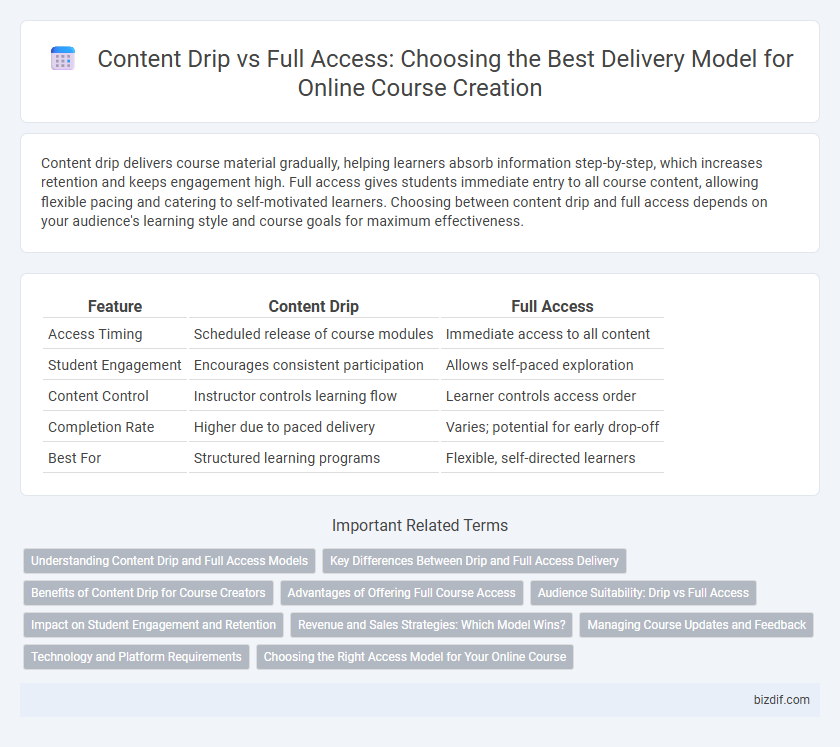Content drip delivers course material gradually, helping learners absorb information step-by-step, which increases retention and keeps engagement high. Full access gives students immediate entry to all course content, allowing flexible pacing and catering to self-motivated learners. Choosing between content drip and full access depends on your audience's learning style and course goals for maximum effectiveness.
Table of Comparison
| Feature | Content Drip | Full Access |
|---|---|---|
| Access Timing | Scheduled release of course modules | Immediate access to all content |
| Student Engagement | Encourages consistent participation | Allows self-paced exploration |
| Content Control | Instructor controls learning flow | Learner controls access order |
| Completion Rate | Higher due to paced delivery | Varies; potential for early drop-off |
| Best For | Structured learning programs | Flexible, self-directed learners |
Understanding Content Drip and Full Access Models
Content drip delivers course materials incrementally, enhancing learner retention by spacing out information over time and preventing overwhelm. Full access grants students immediate entry to all modules, offering flexibility for self-paced learning and quick revision. Choosing between these models depends on course goals, learner engagement strategies, and the complexity of the content.
Key Differences Between Drip and Full Access Delivery
Content drip delivers course materials gradually, releasing modules on a predetermined schedule to maintain learner engagement and prevent overwhelm. Full access provides all course content immediately, allowing learners to progress at their own pace with maximum flexibility. Drip delivery supports structured learning paths while full access caters to self-directed, accelerated study preferences.
Benefits of Content Drip for Course Creators
Content drip enables course creators to release material gradually, increasing student engagement and reducing overwhelm by pacing the learning process. This method supports better knowledge retention and consistent user interaction, leading to improved course completion rates. Controlled content delivery also helps creators monitor progress, gather feedback, and adapt materials efficiently based on learner needs.
Advantages of Offering Full Course Access
Offering full course access empowers learners to control their own pace and revisit materials anytime, enhancing knowledge retention and flexibility. This approach caters to diverse learning styles, reduces frustration, and increases course completion rates by removing time restrictions. Facilitating immediate access to all content also boosts perceived value and encourages student engagement throughout the course.
Audience Suitability: Drip vs Full Access
Content drip suits learners who benefit from paced, structured exposure to material, enhancing retention and reducing overwhelm by releasing course modules gradually. Full access appeals to self-motivated audiences seeking flexibility, allowing them to navigate content in their preferred order and pace. Choosing between drip and full access depends on the audience's learning style, time availability, and need for guided progression.
Impact on Student Engagement and Retention
Content drip delivery strategically releases course materials over time, enhancing student engagement by maintaining consistent interest and reducing overwhelm. Full access allows learners to explore the entire course immediately, catering to self-paced study but risking disengagement due to information overload. Studies show that drip-fed content improves retention rates by fostering a structured learning path, while full access suits motivated students who prefer flexibility.
Revenue and Sales Strategies: Which Model Wins?
Content drip models generate steady revenue by releasing course materials gradually, encouraging ongoing engagement and reducing refund rates, which enhances long-term customer lifetime value. Full access models boost upfront sales by offering instant gratification, appealing to buyers seeking immediate results and increasing average order value during launch periods. The optimal revenue strategy depends on audience behavior and sales funnel design, with drip content favoring subscription-style income, and full access maximizing early cash flow.
Managing Course Updates and Feedback
Content drip allows instructors to release course materials gradually, enabling continuous engagement and easier management of updates by modifying upcoming modules without disrupting the entire curriculum. Full access gives learners immediate entry to all content, which can complicate updates and feedback integration, as changes affect the whole course at once. Managing course feedback is more streamlined with content drip, as sequential release encourages iterative improvements based on learner responses.
Technology and Platform Requirements
Content drip requires a platform with advanced scheduling capabilities and robust automation tools to release course materials incrementally, ensuring controlled learner progression and engagement. Full access demands a scalable infrastructure capable of handling simultaneous, unrestricted access without compromising performance or user experience. Selecting a Learning Management System (LMS) with flexible content management, reliable uptime, and secure access controls is crucial for efficiently supporting either approach.
Choosing the Right Access Model for Your Online Course
Choosing the right access model for your online course significantly impacts learner engagement and completion rates. Content drip delivers course materials gradually, promoting steady progress and reducing overwhelm, while full access allows learners to explore content at their own pace, enhancing flexibility. Evaluating your audience's preferences and course complexity helps determine whether drip scheduling or immediate full access will optimize learning outcomes and retention.
Content drip vs Full access Infographic

 bizdif.com
bizdif.com